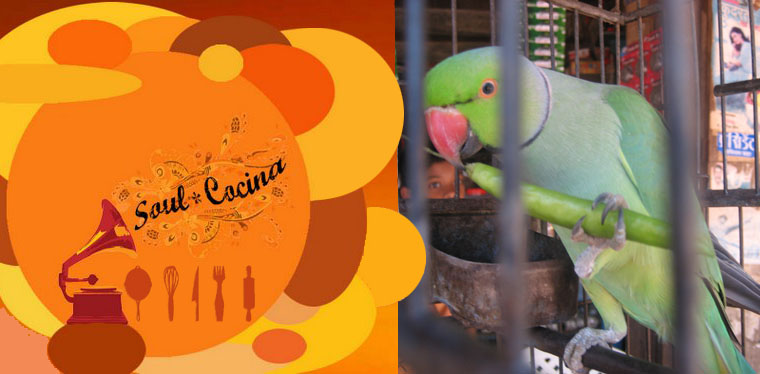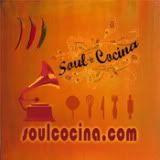
Soul Cocina's Cumbia Clandestina Mix brings together many types of Cumbia into one mix. There's music from Colombia, Peru, Argentina, Mexico, Cuba, El Salvador, Venezuela, USA, Cuba and beyond. Two or three cumbia digital tracks, plenty of cumbias clasicas, some cumbia sonideras, villeras, guarachas, porros, chicha.... Some of the sonideras come from mix CDs from Mexican and US sound systems like Grupo Kual and other Sonidos from Puebla, DF, and Monterey, Mexico. A few come from mixes from DJ's like Alex Perez from Chicago. The cumbias clasicas mostly come from records I have picked up over the years in the US, Latin America, and Europe. The cumbias digitales come from internet downloads from sites like Muy Bastard. I did not include too much nueva cumbia digital, but there is a lot available on the world wide web for downloads. Just search blogs for Chico Sonido, Sonido Martines, Villa Diamante, Oro 11, and the Zizek crew from Argentina and the Tormenta Tropical crew from the SF Bay. I like the Nueva Cumbia that stays close to the original music.. but the experimental stuff is fun too. Some of my favorites are La Super Cumbia Futurista, Chico Sonido and Los Wendys
Wayne and Wax has some words about cumbia.
El Hijo de La Cumbia, Fantasma, El Remolon and Chancha Via Circuito are some other interesting artists from the boom in Buenos Aires.
A lot of sound systems in Latin America are called Sonidos, some sound systems in Colombia are called Picos (Pico Soul Cocina has a nice ring to it) I made this mix to listen to at work.. then I decided to post it here.. so I did not make a tracklisting. With all the requests... I am revisiting the cds, records, and mp3s to put together a tracklist. Some of the tunes come from unlabeled street CDRs. If anyone can help with the few unknown tunes, please drop some knowledge in the comments. Tracklist for Vol I is complete.. Vol II and III coming soon.
I made this mix to listen to at work.. then I decided to post it here.. so I did not make a tracklisting. With all the requests... I am revisiting the cds, records, and mp3s to put together a tracklist. Some of the tunes come from unlabeled street CDRs. If anyone can help with the few unknown tunes, please drop some knowledge in the comments. Tracklist for Vol I is complete.. Vol II and III coming soon.
Big shout out to Salvador, Celso, El Chilango and DJ Rolond from 26 Mix for the Guatemala, DF and Puebla Sonidera Mixes that inspired this Cumbia Clandestina Mix.
Tune: Cumbia Clandestina Mix Vol I
Tracklist for Vol I
1. A Adorar Antonio - Group from Guapi, Colombia recorded in Spring of 1968 by David Lewiston from Black Music of South America - In Praise of Oxala and other Gods
2. La Gallenera Cumbia from Cumbia Soledena vol III LP written by Pedro A Beltran
3. Cumbia del Carnaval by Los Caribes from from their self titled 1979 Disco Gas LP
4. Cumbia Sampuesana from the Disco Fuentes LP called Cumbias y Porros, written by Joaquin Betin
5. El Cazador by Rodolfo y Los Idolos from their Lo Maximo LP on Disco fuentes
6. La Mochila Tercia by Lisandro Meza y Su Conjunto from Las 10 Calientes de Colombia LP on Disco fuentes 1978
7. Juanita Bonita by Los Olimpicos 5 from Pachanga Tropical LP on Mex Sound/ Arriba Records 1978
8. Porro Sabaneros by Orquesta Ritmo de Sabanas feat Lucho Perez y Isaac Villanueva from Las 10 Calientes de Colombia LP on Disco fuentes 1978
9. La Subienda by Gabriel "Rumba" Romero from his Grandes Exitos LP on Disco Fuentes
10. Cumbia del Bajo by Lisandro Meza y Su Conjunto from Las 10 Calientes de Colombia LP on Disco fuentes 1978
11. Cumbia Cienaguera by Luis E Martinez from Disco Fuentes LP Cumbias y Porros
12. Cumbia De El Salvador by El Orquesta Hermanos Flores from their El Mentiroso LP on the Dicesa label.
13. La Chica de Los Ojos Cafe by Los Canoneros de Colombia from the Cumbias de Oro '89 LP from Musart records Mexico
14. Gaita Franetica - from Grupo Kual mix CD (btw the intro is the instrumental source for the San Pancho mix of Arana Hindu on my East of El Rio Dolores Mix)
15. Te Pico de Abeja by Alberto Pedrazo
16. unlabelled song from a street cd that I call "Get Back Cumbia"
17. Chambacu by Aurito Castillo y su Conjunto
18. Cumbieton Rutero by Axel K Soundsystem
19. Juana La Cubana by Fito Olivares
20. Traicionera by Celso Pina
21. Cumbia del Amanecer maybe by Los de Bohio?
22. El Crack by Los Canoneros de Colombia from the Cumbias de Oro '89 LP from Musart records Mexico
Tune: Cumbia Clandestina Mix Vol II
Tune: Cumbia Clandestina Mix Vol III
I didn't include Cumbia de Obama, but you can see the video, read the lyrics and download the song here.
In April Soul Cocina will present a Cumbia Brunch in San Francisco. We will feature the cuisine of the cumbia diaspora in a prix fix menu, a cumbia dancefloor, and of course, cumbia music.
In san Francisco we have plenty of Peruvian and Salvadoran restaurants, but there are very few Colombian restaurants. I picked up some sancocho de gallina with arepas and chorizo to go with the Cumbia Clandestina Mix at Majahual Restaurant in my neighborhood. Arepas are South American tortillas. They are different from Mexican and Salvadorean tortillas because of the special type of corn flour. I learned how to make arepas and empanadas in Venezuela. I was taking a nap on a park bench and a street cleaner woke me up and told me it was not safe for tourists to nap in that park. We began to chit chat, and when she found out that I was a chef looking for recipes and records.. she invited me to her home for a lesson in arepas and empanadas. Her daughter was studying tourism, so she was excited to show me her city, Caracas, and help me find vinyl records and cassette tapes. I still remember my Un Solo Pueblo tape that I bought on that trip.. I need to convert it to digital sound. This was in 2000. Hugo Chavez had just taken office, and my hosts were strong supporters. Turns out Marisa (the street cleaner) was working for a program under Chavez's Plan Bolivar besides arepas and empanadas, I also learned how to prepare a glorious condiment used for the late night street hot dogs called Guasacaca (nice name?!)
The guasacaca sauce that I learned to make and that I tasted all over Caracas is made from avacados, parsley, hot peppers, green pepers, oil, vinegar, and garlic.
The recipes I see in books and on the web are all very different from this. They are more like guacamole. The guasacaca I grew to know and love is pureed up to a smooth sauce. I like guasacaca with plain or cheese arepas, but in Caracas, guasacaca seemed to be used as a condiment for hot dogs.
Arepas are made from a dough made from peeled corn kernals (maiz pilado) that are ground and par-cooked, then mixed with water. Today, most people buy arepa flour, which is cornmeal made from a specific part of the corn kernal (cotyledons) that has been partially cooked. There is no Nixtamalization process for arepa corn flour. Once you get the arepa flour, it is just like making fat tortillas or stuffed pupusas. many recipes call for oil or butter and even milk in arepas, but I learned to make arepas with just water and salt. They can be stuffed with cheese or meat.
I am excited to try out the Pica Pica South American restaurant in Napa at the Oxbow Public Market
Quiere mas Colombian cuisine?
What are the kids of Colombia up to today?
While I was making this mix I heard Hellicopters swarming above our house. I looked out to find a 4 alarm fire a few blocks away, down the hill, in a building we used to live in a few years ago. Here is what I saw from our back door.
Tuesday, March 18, 2008
Cumbia Clandestina
Subscribe to:
Posts (Atom)






